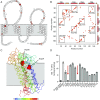Identification of the gene that codes for the σ2 receptor
- PMID: 28559337
- PMCID: PMC5502638
- DOI: 10.1073/pnas.1705154114
Identification of the gene that codes for the σ2 receptor
Abstract
The σ2 receptor is an enigmatic protein that has attracted significant attention because of its involvement in diseases as diverse as cancer and neurological disorders. Unlike virtually all other receptors of medical interest, it has eluded molecular cloning since its discovery, and the gene that codes for the receptor remains unknown, precluding the use of modern biological methods to study its function. Using a chemical biology approach, we purified the σ2 receptor from tissue, revealing its identity as TMEM97, an endoplasmic reticulum-resident transmembrane protein that regulates the sterol transporter NPC1. We show that TMEM97 possesses the full suite of molecular properties that define the σ2 receptor, and we identify Asp29 and Asp56 as essential for ligand recognition. Cloning the σ2 receptor resolves a longstanding mystery and will enable therapeutic targeting of this potential drug target.
Keywords: NPC1; TMEM97; cholesterol regulation; sigma receptors; sigma-2 receptor.
Conflict of interest statement
Conflict of interest statement: The authors are inventors on a provisional patent application related to the work described in this article.
Figures



Comment in
-
Cloning the sigma2 receptor: Wandering 40 years to find an identity.Proc Natl Acad Sci U S A. 2017 Jul 3;114(27):6888-6890. doi: 10.1073/pnas.1708155114. Epub 2017 Jun 23. Proc Natl Acad Sci U S A. 2017. PMID: 28645899 Free PMC article. No abstract available.
References
-
- Lefkowitz RJ. A brief history of G-protein coupled receptors (Nobel Lecture) Angew Chem Int Ed Engl. 2013;52:6366–6378. - PubMed
-
- Martin WR, Eades CG, Thompson JA, Huppler RE, Gilbert PE. The effects of morphine- and nalorphine- like drugs in the nondependent and morphine-dependent chronic spinal dog. J Pharmacol Exp Ther. 1976;197:517–532. - PubMed
-
- Hellewell SB, Bowen WD. A sigma-like binding site in rat pheochromocytoma (PC12) cells: Decreased affinity for (+)-benzomorphans and lower molecular weight suggest a different sigma receptor form from that of guinea pig brain. Brain Res. 1990;527:244–253. - PubMed
-
- Abramson Cancer Center of the University of Pennsylvania (2014) Imaging of in vivo sigma-2 receptor expression with 18F ISO-1 positron emission tomography (PET/CT) in primary breast cancer. Clinical trial NCT02762110. Available at https://clinicaltrials.gov/ct2/show/NCT02762110?term=NCT02762110&rank=1. Accessed November 2, 2016.
-
- Cognition Therapeutics (2016) Clinical trial of CT1812 in mild to moderate Alzheimer's Disease. Clinical trial NCT02907567. Available at https://clinicaltrials.gov/ct2/show/NCT02907567?term=NCT02907567&rank=1. Accessed November 2, 2016.
Publication types
MeSH terms
Substances
Grants and funding
LinkOut - more resources
Full Text Sources
Other Literature Sources
Molecular Biology Databases
Research Materials

